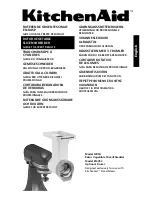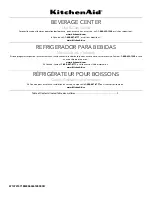
1. Setting up
The Korn-Quetsche should have a permanent place in your kitchen.
With the enclosed screw clamp you fix the Korn-Quetsche firmly to a table or
sideboard (max. 50 mm thick, 40 mm protruding depth). For a secure set up, the
four rubber feet should contact the tableboard. Shift the screw clamp into the
screw hole of the bottom plate and tighten firmly.
2. Operation
Running in:
When using the Grain-Flaker for the first time, please discard the
first 100 g of flakes.
Model with wooden top: Before usage, please make sure that the funnel contacts
the supports. For flaking turn the handle exclusively clockwise. Avoid to turn it
anti-clockwise as the grains could penetrate upwards and may cause damage to
the tops of the funnel (aluminium) or lift it (wood).
The texture of the flakes, resp. the gap, can be varied by slight adjustments of the
two wing or knurled nuts. Please turn these only in little bits (tighten: right-turn,
loosen: left-turn) and at the same time. The factory setting (state of delivery)
allows you to process all items that are mentioned under n° 3. Flour-fine flakes
are received by flaking several times.
Factory setting:
Loosen the wing nuts/knurled nuts until they are no longer
under tension. Tighten the nuts (right turn) until they are under tension and the
second roller starts to turn. Then fill in the grains, turn the handle and eventually
readjust the nuts equally.
Removal of the wooden top: Loosen the two wing/knurled nuts at the same time,
then remove the top. When putting it back again, make sure that it contacts the
supports, then tighten the two nuts slightly until they are under tension (refer to
factory setting).
3. Use
With the Eschenfelder Korn-Quetsche you can flake any grains, except corn, even
moist grains like f.e. wheat sprouts (please mind to let these trickle one after the
other). Due to the steel rollers, you can flake oily seeds like linseed, sunflower
seeds, pumpkin seeds etc. You may flake even poppy seeds as an ingredient for
your müsli, the result though is not comparable with the one from a special poppy
seed mill. Also spices like anis, fennel, cumin, cinnamon, mustard seeds,
cardamon, coriander etc. and even chopped nuts, dried herbs, lentils and little
pieces of dried fruits, f.e. raisins mixed with grains, can be flaked.
4. Cleaning and treatment
Never
put the Korn-Quetsche into the dish-washer!
Wooden parts: May cleaned with a moist towel.
Do not use any detergent!
Flaking mechanism: It requires a regular cleaning. Especially after having flaked
oily seeds), spices or exclusevily oats (fatty). It is often sufficient to just flake
some rice directly afterwards - it carries any leftovers off the rollers. The knurling
of the rollers must stay clean, as it guarantees the take out of the grains. Also the
lateral gap between roller and lace is to be cleaned regularly. With a bristle brush
or a tooth brush you can easily brush off the leftovers while turning the rollers.
Don’t bend the laces that touch the rollers while cleaning.
No soaking of the wooden parts.
No arbitrary dismantling of the Flaker!
Savety note:
Don‘t leave children, under no circumstances, without
supervision.
Do not use the flaker without the top, never reach into the funnel
between the rollers. Carry leftover grains with a bristle brush towards the gap.
5. Maintenance
The wooden runnings (notch in the supports that take the rollpin) have to be treated
every once in a while, especially when the turning becomes rough-running. For that
purpose put some vaseline on the rollpin and work it in by turning the rollers.
Please don’t use any other grease.
The solid beech wood is treated with organic linseed oil and may be retreated.
6. Warranty
The Korn-Quetsche comes with a 2 year warranty from date of purchase (proof of
purchase) on the condition that it has been used accordingly. The warranty covers
defects that can be traced as material- or mannufacturing defects. Explicitly not
covered by the warranty is: Any damage caused by natural abrasion, improperly
treatment or impacts (like f.e. the dismantling of the flaking mechanism); damage
that is caused by foreign bodies in the grains resp. by improper grains: minor
damages that reduce the usability or value of the device insignificant. Unless legally
required, we reserve the right of decision for repair or replacement. The dealer's
obligations to the customer are not affected by this warranty.
Please contact us in case of warranty.
7. Technical details
Flaking mechanism: two nickelfree stainless steel rollers, operation without
gears, free from wear
Case:
solid indigenous beech from certified sustainable forest
inventory, surface treated with organic linseed oil
Funnel:
anodized aluminium (firmly installed) or wood: beech/
core beech/walnut - (removable)
Chute: nickelfree stainless steel
easy cleaning due to open construction
Output:
One dish cereals (50 gr) ca. 20 sec. Flour is gained by
flaking several times
Texture of flakes: continious adjustment
Wing/knurled nuts (stainless steel) depending on model
Flaking material:
any grains except corn, dry or moist, oily seeds, spices,
leguminous plants and many more.
Measurements: Heights 24 cm, Width 12 cm, Depth 24 cm
(incl. handle)
Handle: Standard: 20 cm
Extra long: 25 cm (on demand)
Screw clamp:
Tableboards up to 4,5 cm thickness
Protruding depth min. 4 cm
8. Hints for daily use
Replace flour or starch through grain flakes:
To thicken sauces, as ingredients for soups, make crunchy flakes, for porridge and
pancakes, for baking and above all fresh flakes for your vital breakfast.
For baking cake and bread: You may replace half of the flour for the dough through
flakes. (Apple-) Pancakes become especially crispy with buckwheat flakes.
You can refine any dishes, either sweet or spicy, with fresh flaked spices, nuts or
dried fruits for any taste.
We wish you a lot of pleasure with your Korn-Quetsche!
For any questions we will be happy to be at your disposition
Korn-Quetsche/Grain Flaker
Instructions for use
Congratulations!
With the Korn-Quetsche you have purchased a kitchen device that has been developed for a healthy
nutrition and in consideration of ecological principles.




















